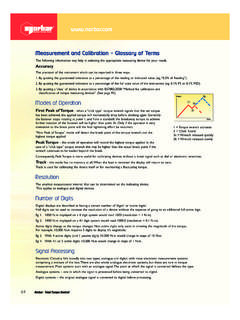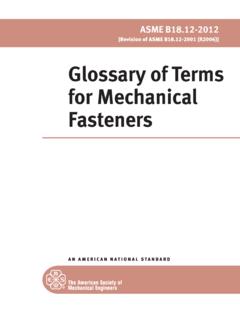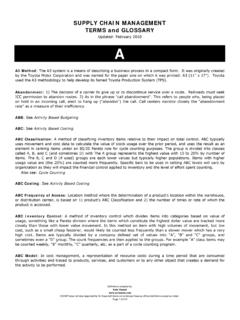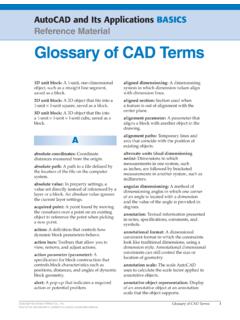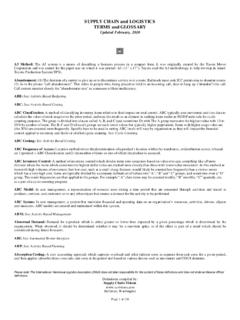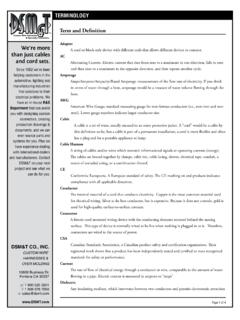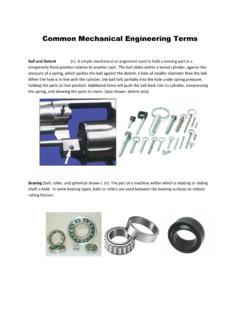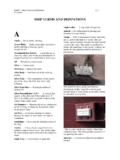Transcription of Glossary of Terms - 4urplace.com
1 Glossary of Terms Glossary of Insulation Terms and Symbols Solving insulation problems depends on a knowledge and understanding of the Terms and symbols used in calculation methods. Included here are relevant Terms and their definitions along with appropriate symbols to help simplify your thermal calculations. British Thermal Unit (BTU): A unit of heat defined generally as the quantity of heat required to raise the temperature of one pound of water one degree Fahrenheit. Calculated Thermal Values: An arithmetic summation of the resistances for all the components making up a building section including surface air films. This method of calculation does not consider the thermal short circuit effect of structural members, fastener population, compression of insulation material at structural member and may indicate lower heat loss values for a building envelope than may actually develop in the finished structure.
2 Degree Days (DD): A measure of the severity of a heating period, usually an entire season, based on climatic conditions. It is found by determining from weather records for each day the difference between 65 degrees F. and the mean temperature for that day. The sum of these differences for all the days in the heating season is the Degree Days for that locality. Density (D): A measure of the mass per unit volume defined as the number of pounds per cubic foot of volume. Dew-Point: The temperature at which cooled air, with no change in pressure or amount of water vapor, becomes completely saturated and forms visible condensation (attains a relative humidity of 100%).
3 Guarded Hot Box: Test procedure used to accurately determined thermal conductance or heat flow through a non-homogeneous building section. The construction of the Guarded Hot Box and the procedure for test is governed by ASTM Test Method C236. Where accurate measurements of heat loss (U- value) through a building envelope are required, it is strongly recommended that this method of determination be used. (1 of 3)3/21/2006 6:31:19 AM. Glossary of Terms Humidity, Relative: This indicates, as a percentage, the amount of moisture that air of a given temperature is actually holding in vapor form as compared to what it could hold at that same temperature when fully saturated.
4 Light Reflectance: The measure of light reflectance is that fraction or percent of available light which is reflected by the surface. Greater percentages indicate more light being reflected from the surface in question. Overall Heat Transmission Coefficient (U): A unit expressing heat passage through a complete building section, including air films. Technically, it is heat transmission in BTU per hour, per square foot, per degree Fahrenheit of temperature difference from air to air for a composite building section. It is the reciprocal ( , divided into 1) of the total resistance of the section, 1/R. It is used as a basis for determining transmitted heat loss.
5 The lower the U-value, the better the insulating value of the building section. Perm: A vapor transmission rate of 1 grain of water vapor per square foot, per hour, per inch of mercury pressure difference (1 pound = 5,760 grains). The lower the perm, the better the resistance to water vapor transmission. Sound Absorption (Noise Reduction Coefficient): A measure of the ability of surface to absorb a fraction of the randomly incident sound. Measurements are taken at 125, 250, 500, 1000, 2000, and 4000 cycles and NRC is the average of coefficients at 250, 500, 1000 and 2000 cycles. The higher the NRC value, the more sound has been absorbed by the surface.
6 Sound Attenuation (Sound Transmission Class): A measure in decibels of the reduction in sound as it passes through a wall or roof. The higher the STC value, the better are the sound attenuation properties of the construction in question. Surface Air Film coefficient (f): The amount of heat flow in BTU per square foot per hour between an exposed surface of a material and the adjacent air, fi - inside surface film coefficient, fo - outside surface film coefficient. It is a measure of the conductance of heat through the air film that clings to all surfaces. The resistance of such films is expresses as 1/f. Values can be found in the ASHRAE Handbook of Fundamentals.
7 (2 of 3)3/21/2006 6:31:19 AM. Glossary of Terms Thermal conductance (C): A unit specifying the amount of heat, in BTU's per hour, that passes through a square foot of material which has a given thickness and one degree Fahrenheit of temperature difference between its surfaces. Used for comparing insulating efficiencies of materials with varying but stated thicknesses or those which are composed of two or more basic materials. The lower the conductance value, the less amount of heat is permitted to pass through the non-homogeneous section. Ankeny Location Map Home Page E-mail to MBI Top of Page Back to MBI. (3 of 3)3/21/2006 6:31:19 AM.
